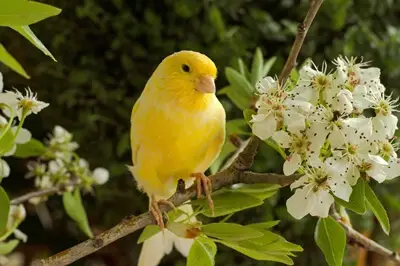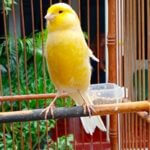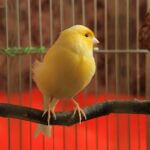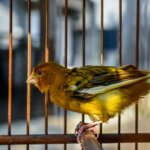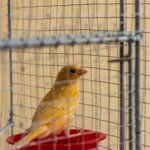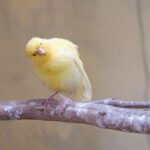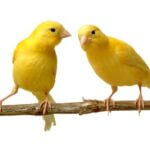Molting occurs when a canary sheds its old feathers and regrows new ones.
Although it’s stressful and takes a physical toll, it’s entirely natural. The canary would have damaged feathers, skin issues, hygiene problems, and trouble regulating temperatures if it didn’t molt.
Molting allows the canary to get rid of old, damaged, worn-out feathers and replace them with bright, healthy, and new ones.
It can also prepare for winter and summer by shedding feathers and regrowing the kind it needs to handle seasonal change.
When Do Canaries Molt?
Canaries molt once a year, usually around late summer or early fall.
The timing of your canary’s molt will depend on the amount of daylight in your area, and molting will happen shortly after the decline in peak daylight hours.
However, external factors can also affect when a canary enters a molt, leading to molting out of season, which is known as a soft molt or a shock molt.
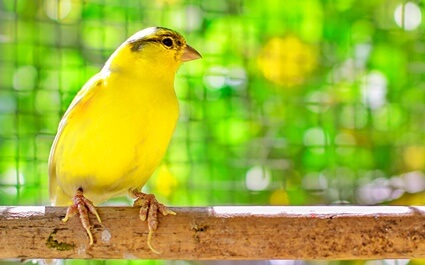
Out-of-Season Molting
A canary may molt out of season due to the following:
- Stress
- Fear or trauma
- Illness
- Overly warm temperatures or fluctuating temperatures
- Thyroid disorders
However, the most common reason for an out-of-season molt is artificial lighting.
According to Physiology and Behavior, molting male canaries responded to light differently than those that weren’t molting.
For example, if you often go to bed late, you might keep the lights on for longer. For your canary, this means a longer day cycle.
To prevent molting out of season, ensure your canary gets no more than 8-10 hours of daylight per day, or keep your canary in darkness once the sun goes down.
How Long Does Molting Last in Canaries?
Molting in canaries usually lasts 6-8 weeks. However, some molts can safely last up to 10-12 weeks.
If your canary is still molting after 12 weeks, you should check the following:
- Diet
- Lighting
- Ambient temperature of the room
If any of these factors are disruptive to your canary, they could make it undergo molting for longer than necessary. This isn’t only taxing emotionally but can be physically damaging.
Partial vs. Full Molt
Juveniles go through a partial molt (or soft molt) where they won’t molt their flight or tail feathers. This results in their flight and tail feathers remaining white, while the rest of them will be yellow (or whatever natural color your bird is).
Once they are adults, juveniles will go through a full molt. During its full molt, the canary will finally have an even shade throughout its entire body.
How To Tell If A Canary Is Molting
Molting canaries will manifest clear signs, both physical and behavioral. Physical signs include:
1/ Loose And Disheveled Feathers
Before a molt, a canary’s feathers will look loose and unkempt. This is in preparation for the old feathers to dislodge and come out.
2/ Feathers At The Bottom of The Cage
Molting begins with the shedding of a few feathers. You’ll notice these gatherings on the bottom of your bird’s cage. Their number will steadily increase as the molt continues.
At the height of a molt, the bottom of your bird’s cage may be entirely covered in feathers, depending on how often you clean the enclosure.
This amount of feather loss is completely normal. As long as new feathers are growing in, you don’t have to worry about your canary.
3/ New Feather Growth
New feather growth will appear like pins from a canary’s skin, aptly named feather pins. This ‘pin’ is a hollow tube, which is the bony middle of a fully-grown feather.
Eventually, the shaft will grow longer, and the barbs (or the softer outer edge of the feather) will grow. New feathers often grow on the face and head before anywhere else.
4/ Puffed Up Feathers
When a canary is molting, you might notice its feathers are puffed up because birds in molt feel colder. Fewer feathers mean less protection from the surrounding temperatures.
Additionally, it’s harder for a bird to warm itself up because raising body temperature requires a lot of energy. Since it’s molting, it doesn’t have the energy to spare.
A bird may also be puffed up because it feels stressed or uncomfortable during the molt. If you think your canary is stressed, consider warming up its room and giving it a more nutritious diet.
5/ Canary Molting Behavior
Canaries that are molting will behave differently. Changes to its personality or habits include becoming:
- Drowsy: Molting canaries can begin looking sleepier than usual.
- Withdrawn: Molting canaries will be less willing to interact since they don’t have the energy.
- Lethargic: Your bird may be less energetic and sleep more in the daytime.
- Lack of appetite: Less commonly, molting birds want to eat less, especially if stressed. If this happens, make sure your canary has a nutritionally dense diet.
- Irritable: Birds uncomfortable with their molt will be louder and more irritable.
- Preening: This encourages older feathers to fall off and eases the discomfort of new feathers growing in their place.
Do Canaries Stop Singing When They Molt
Male canaries stop singing when they molt. There’s still research needed on the connection between molting and singing. However, the most common theory is that singing takes up energy.
According to The Association For The Study Of Animal Behavior, singing increases a bird’s metabolic rate. Molting also does this, so a canary losing and regrowing its feathers may lack enough energy to sing.
Male canaries should resume singing when the molting period is finished. If yours doesn’t, check the bird’s health, nutrition, and stress levels.
The most common problem is that it was underfed throughout the molting process, so it is still endeavoring to rebuild its energy reserves.
A lack of singing doesn’t predict a molt. Male canaries only halt singing in the middle of this period, not before. If your bird goes silent before its molt, it may have an illness or other condition.
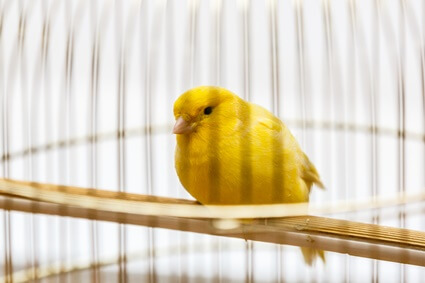
How To Take Care Of A Molting Canary
Molting is a difficult time for canaries, but here are some ways to ease their stress and discomfort:
Diet
A molting canary will need more protein and fat, as this will produce new feathers since they’re about 85-90% beta-keratin. You can add oil-rich seeds to your canary’s food bowl, including:
- Niger
- Flax
- Hemp
Bathing
A bird bath should be constantly available for molting canaries. Bathing moisturizes the old feathers, allowing them to fall out more easily, soothing irritated skin, and helping new feathers grow.
You can also use feather sprays, which are store-bought formulas that can be sprayed directly onto the feathers. If your canary dislikes bird baths, this can be a viable alternative.
Toys
Canaries may become more aggressive or listless when they’re molting.
To help, provide additional toys or swap out the current ones with fresh varieties. This will distract your canary from its emotional distress and give it a project on which to focus its negative attention.

